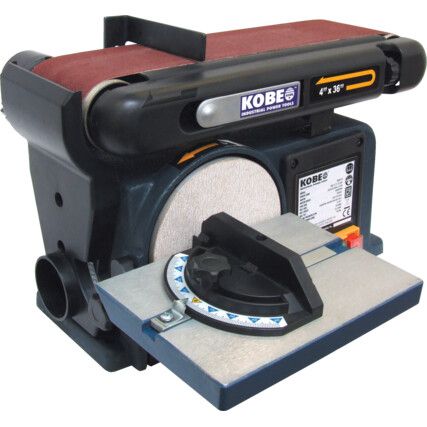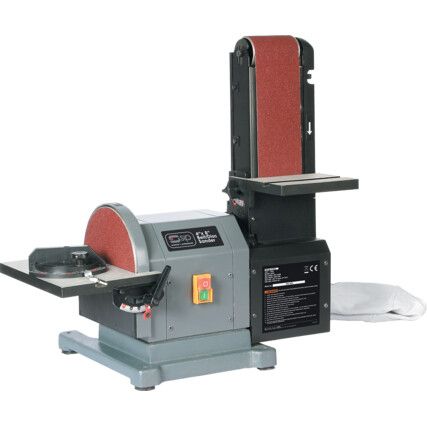Sanding Machines
The Cromwell range of belt sanders feature big name brands such as Ajax, Hikoki and Black and Decker, so you'll be assured of quality and choice when selecting the right tool for your requirements.
What are belt sanders?
Belt sanders are multi use tools that excel at the rapid removal of stock wood. They can be used to sand rough surfaces and trim to scribed line as well as rounding off edges and freehand applications. Their sanding action is linear so unlike other sanders you can achieve a good finish with even coarse grits. They are usually a part of a carpenter's arsenal but many experienced hobbyists also utilise them.
Why belt sanders?
Powerful and large, belt sanders are usually deployed as the grunt tools of sanding, their ability to remove material quickly can save a lot of time with long projects, however because of this rapid stock removal if inexperienced with them they have the potential to make a mess of things meaning you'll have to start over with a fresh surface. However, in the right hands they are an extremely valuable tooling option.
When belt sanders?
Belt sanders are designed in a many different sizes and varieties that can be used in a wide range of woodworking, carpentry, crafting, DIY and hobbyist setting.
Belt sander types
Belt sanders come in a few different sizes and varieties so to give you the general scope of their individual features and benefits.
• Hand powered belt sander Hand powered belt sanders commonly come with the following belt sizes 3" x 21", 3" x 18" and 4" x 24". They are ideal for sanding worktops and decks and feature either chorded or battery operation.
• Tube sanders These are sometimes referred to as pip polishers as their design operates around a pulley system that contours to tubular objects.
• Belt file sanders These types of sanders are usually handheld with a narrow, small sanding belt (typically sizes include 1/2" x 18", 3/8" x 13" and 1/2" X 24"). Their design is ideal for fitting into tight workspaces or removing welds from inside corners.
• Floor sanders These types of belt sanders are pushed around with a handle (think much like a vacuum cleaner) in order to cover large areas of wooden flooring, typical belt sizes include 8" x 19", and 7-⅞" x 29-½.
• Stationary belt grinders Usually mounted on a work bench or feature their own stands. Their assembly depends on the application so they ten to be specific to more niche applications.
Considerations when choosing a belt sander
There are many things to consider when choosing the right belt grinder for your chosen application. The most common of which are outlined below.
• Area to be sanded - The surface area being sanded is one of the key considerations when choosing the type of belt sander to use. For example a file sander being used on a large decking area would prolong the job and potentially leave an uneven finish due to it's narrow design, which a hand sander would not. Likewise trying to sand a tubular item with a standard hand sander would prove highly difficult, in which case a tube sander would be the appropriate choice.
• The material to be sanded - The sizes and grit of the belt are also considerations when it comes to choosing the right belt sander for the job. Typically, there are four distinctive types of grit for belts each suitable for abrading different materials.
For example, aluminium oxide is a popular choice for would and softer metals with a good general purpose sanding capability. Zirconia alumina is considerably harder and is ideal for grinding metal and hardwoods but requires a lot of force to do so. Ceramic has the advantage of being self-sharpening and cooler than most sanding belts and are most suited to metalworking. Silicon carbide has the advantage of being the sharpest grit and cut quicker and more efficiently but they are more susceptible to breakage due to their more brittle nature.
Then there is the grading of the grit for the job. Typically, the lower the number the coarser the belt will be. As a rule low numbers are better for coarse rougher work, mid-range for minor work, and the higher numbers are ideal for finishing off work pieces.
FAQ
Are belt sanders faster?
Belt sanders are a fast and efficient way to sand surfaces and quicker than most other types of sander with much more power and grunt behind them. Some belt sanders have a variable speed switch to increase the feed rate of the belt and sand surfaces faster depending on the material you are sanding.
What are belt sanders good for?
Belt sanders can be used on a range of materials. Although typically used on wood, some types of belt sander, such as tube sanders and stationary sanders can be used on metals.
Note: Be sure to take appropriate precautions like safety glasses and other protective equipment when operating belt sanders.

